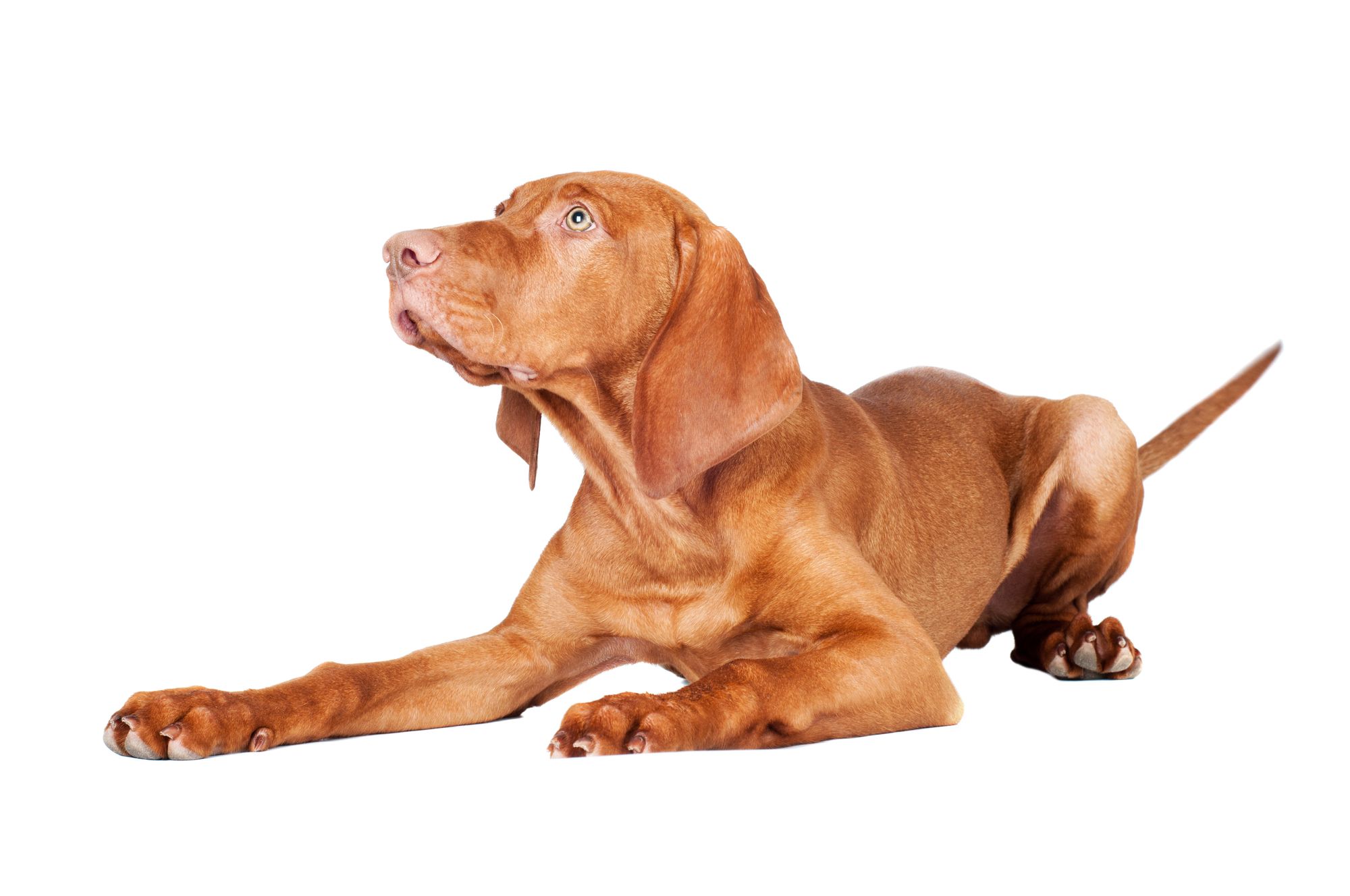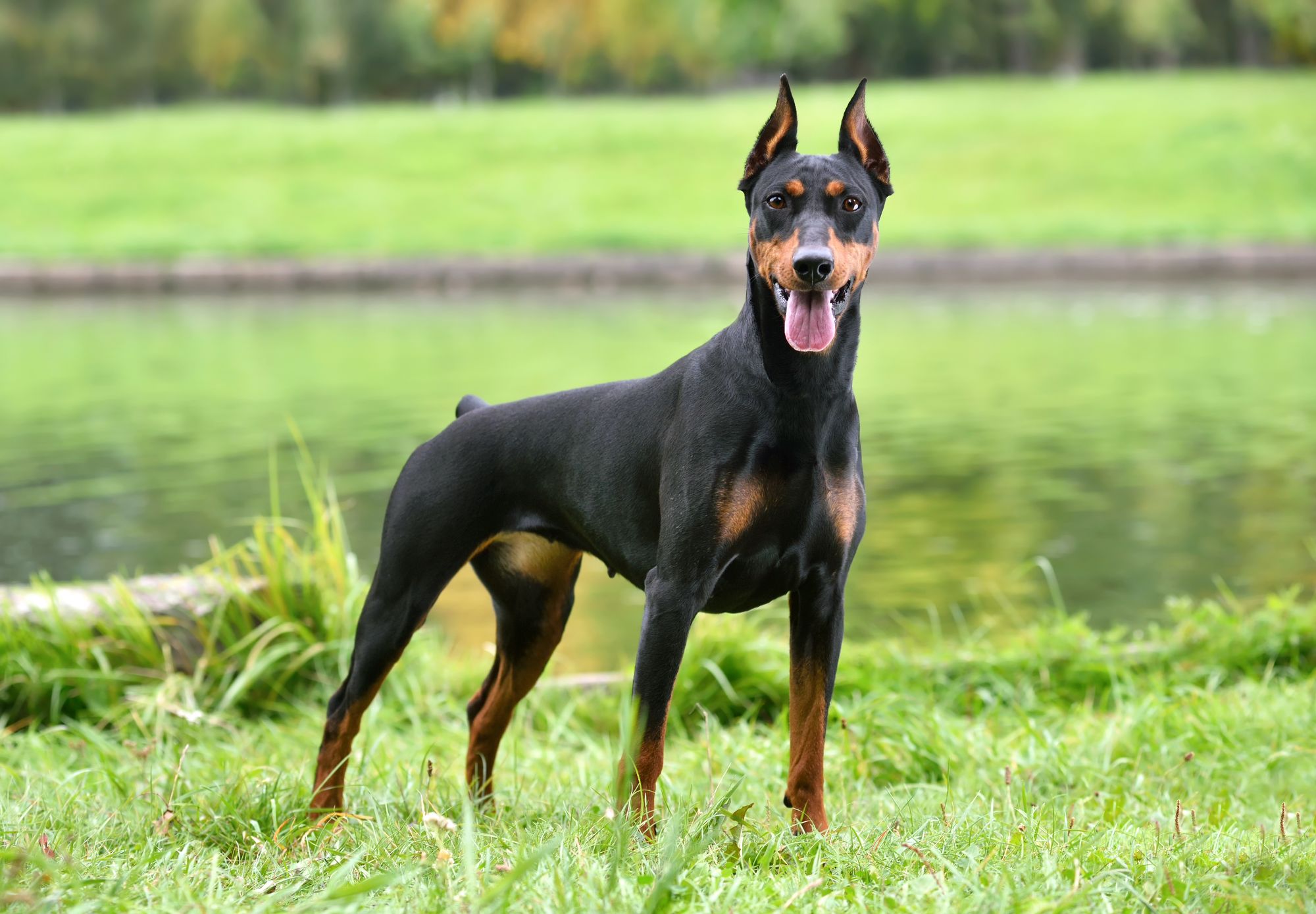Vizslas and Dobermans are two distinct breeds of dogs, each with their own unique characteristics and traits. Understanding the qualities of each breed can help you make an informed decision when choosing the right dog for your lifestyle and preferences.

Vizslas, known for their affectionate and energetic nature, have several key traits. In terms of appearance, they have a lean, muscular build and a short, rust-colored coat. Vizslas are renowned for their friendly and gentle temperament, making them excellent family pets. They have high exercise needs and thrive in active environments. Vizslas are also known for their trainability and intelligence, making them adaptable to various training techniques.
On the other hand, Dobermans possess their own set of defining characteristics. They have a more robust and powerful appearance, with a sleek coat and a muscular frame. Dobermans have a loyal and protective nature, making them excellent watchdogs. While they also require regular exercise, Dobermans have a slightly lower energy level compared to Vizslas. They are highly trainable and possess exceptional intelligence, often excelling in obedience and other advanced training tasks.
When comparing Vizslas and Dobermans, several aspects come into play. In terms of size and physical characteristics, Dobermans are generally larger and more imposing than Vizslas. As for temperament and personality, Vizslas are known for their friendliness and affection, while Dobermans are more protective and reserved. In terms of exercise and activity requirements, Vizslas need more daily exercise and mental stimulation to thrive, whereas Dobermans have a slightly lower exercise demand. Both breeds are highly trainable and intelligent, although Dobermans often require more structured training due to their protective instincts.

Ultimately, the choice between a Vizsla and a Doberman depends on your specific preferences and lifestyle. Consider factors such as exercise needs, temperament, and the amount of time you can dedicate to training and providing mental stimulation. Properly assessing these factors will help you determine which breed is the right fit for you and your family.
Vizslas: Characteristics and Traits
Vizslas, known for their distinctive characteristics and traits, captivate dog lovers with their unique qualities. In this section, we will explore what sets Vizslas apart. From their beautiful appearance to their temperament, exercise needs, and training intelligence, we will uncover the fascinating aspects that make Vizslas stand out among other breeds. So, get ready to dive into the world of Vizslas and discover the reasons why they have become such beloved and sought-after companions.
Appearance
When considering the appearance of Vizslas and Dobermans, there are distinct characteristics that set them apart:
- Vizslas: They are medium-sized dogs with a sleek and muscular build. Their appearance is enhanced by their short, dense coat that is golden rust in color. Additionally, Vizslas have long and floppy ears, as well as a usually docked tail.
- Dobermans: They are large dogs with a powerful and compact build, making their appearance quite imposing. Dobermans possess a short, smooth coat that can come in a variety of colors, including black, red, blue, and fawn. As for their ears, they are naturally floppy, although cropping is often done to give them an alert and distinguished look.
The Vizsla breed originated in Hungary and has a history dating back centuries. They were initially bred for hunting, and throughout time, their appearance has remained distinct and captivating. Vizslas have always been highly prized for their ability to point and retrieve game.
On the other hand, Dobermans were developed in Germany by Louis Dobermann in the late 19th century. These dogs were meticulously bred with versatile working capabilities in mind. Throughout the years, Dobermans have excelled in areas such as guarding, police work, and search and rescue. Today, both breeds are highly regarded for their remarkable appearance and exceptional capabilities.
Temperament
| The temperament of both Vizslas and Dobermans can greatly influence their suitability as pets or working dogs. |
| Vizslas are known for their friendly and affectionate nature. Their temperament is often described as gentle and adaptable to various environments and lifestyles. |
| Dobermans, on the other hand, have a more assertive and protective temperament. They are recognized for being loyal, fearless, and highly trainable. |
| When it comes to compatibility with children and other animals, Vizslas are generally good, making them a great choice for families. |
| However, Dobermans require strong leadership and early socialization to ensure they develop good behavior around children and other animals. |
| Vizslas are highly sensitive dogs who thrive on companionship and human interaction. |
| In contrast, Dobermans are known for their loyalty and deep devotion to their families. |
Pro-tip: When selecting a dog based on temperament, it's important to consider your lifestyle, experience, and ability to meet the specific needs of each breed.
Exercise Needs
The exercise needs of Vizslas and Dobermans vary based on their physical characteristics and energy levels.
- For Vizslas, meeting their exercise needs is essential as they are energetic and active dogs, requiring daily physical and mental stimulation.
- Similarly, Dobermans have high activity levels and it is important to provide them with regular exercise to maintain muscle tone and prevent behavioral problems.
- Both breeds benefit from a routine that includes long walks, jogs, and interactive play sessions.
- Vizslas thrive in activities such as agility training, hiking, and swimming, which contribute to their exercise needs.
- On the other hand, Dobermans enjoy activities like obedience training, fetch, and advanced agility courses, which help fulfill their exercise needs.
Training and Intelligence
When comparing the training and intelligence of Vizslas and Dobermans, it's important to consider their respective characteristics and traits. Vizslas demonstrate both high intelligence and a keenness to please, which allows them to excel in a variety of activities like obedience training and agility.
They are quick learners and respond exceptionally well to positive reinforcement methods. On the other hand, Dobermans are renowned for their exceptional intelligence and trainability. Their strong desire to please their owners enables them to excel in advanced training and tasks such as protection work and search and rescue. It is vital for both breeds to receive consistent training and mental stimulation in order to thrive.
Dobermans: Characteristics and Traits
Dobermans, the elegant and powerful canine companions, possess a remarkable set of characteristics and traits. In this exciting exploration, we'll uncover the distinct aspects that make Dobermans stand out from the pack. From their striking appearance to their unique temperament, exercise needs, and training intelligence, we'll unveil the fascinating world of Doberman traits. Get ready to discover the allure and exceptional qualities that set Dobermans apart in the realm of dogs.

Appearance
The appearance of Vizslas and Dobermans can be compared and contrasted by examining their physical characteristics.
| Vizslas | Dobermans | |
|---|---|---|
| Size | Medium-sized dogs with a lean and muscular build | Large-sized dogs with a strong and robust physique |
| Coat Color | Shades of golden rust | Black, blue, red, or fawn, with rust-colored markings |
| Coat Texture | Short and smooth | Short and sleek |
| Ears | Long and floppy | Cropped or natural, standing upright |
| Tail | Natural, usually docked for aesthetic purposes | Docked or left natural, with a sleek and slender appearance |
| Overall Impression | Elegant and athletic, exuding grace and agility | Powerful and muscular, radiating strength and confidence |
By considering the appearance of these breeds, potential owners can determine which physical characteristics appeal to them the most.
Based on their appearance, Vizslas and Dobermans can be compared and contrasted by exploring their physical characteristics.
| Vizslas | Dobermans | |
|---|---|---|
| Size | Medium-sized dogs with a lean and muscular build | Large-sized dogs with a strong and robust physique |
| Coat Color | Shades of golden rust | Black, blue, red, or fawn, with rust-colored markings |
| Coat Texture | Short and smooth | Short and sleek |
| Ears | Long and floppy | Cropped or natural, standing upright |
| Tail | Natural, usually docked for aesthetic purposes | Docked or left natural, with a sleek and slender appearance |
| Overall Impression | Elegant and athletic, exuding grace and agility | Powerful and muscular, radiating strength and confidence |
By considering the appearance of these breeds, prospective owners can determine which physical characteristics they find the most appealing.
Temperament
When comparing the temperament of Vizslas and Dobermans, it is important to note that there are some key differences between the two breeds. Vizslas are well-known for their friendly and affectionate nature, which makes them an ideal choice for families. They are highly sociable creatures and tend to get along well with both children and other pets.
On the other hand, Dobermans are known for their more protective and guard dog temperament. They are extremely loyal and fearless, making them excellent watchdogs. However, they may exhibit more reserved behavior when it comes to strangers, so early socialization is important. Ultimately, the decision between these two breeds will heavily depend on your lifestyle and personal preferences for a companion.
Exercise Needs
Regular exercise is of utmost importance for both Vizslas and Dobermans to meet their exercise needs and maintain their physical and mental well-being. Here are their specific exercise requirements:
- Vizslas: With their high energy levels, Vizslas necessitate daily vigorous exercise options such as running, playing fetch, or engaging in dog sports.
- Dobermans: Similar to Vizslas, Dobermans are energetic dogs that require regular exercise, which includes daily walks, active play sessions, and mental stimulation like obedience training.
Meeting their exercise needs is crucial in order to prevent behavioral issues and ensure their continued happiness and well-being. Tailoring daily exercise routines to their individual requirements and abilities is essential.
Training and Intelligence
| Training | Vizslas: They excel in training and are highly trainable, always eager to please their owners. | Dobermans: They are intelligent and quick learners, which makes training them highly successful. |
| Intelligence | Vizslas: They are renowned for their exceptional intelligence and problem-solving skills. | Dobermans: They are widely recognized as one of the most intelligent dog breeds. |
Both Vizslas and Dobermans possess high levels of intelligence, which contributes to their outstanding aptitude for training. This makes them ideal candidates for tackling challenging tasks and advanced obedience training. It's important to note that individual dogs may display variations in trainability and intelligence.
Comparison: Vizsla vs Doberman
When it comes to comparing Vizslas and Dobermans, there are a few key aspects that set them apart. From their size and physical characteristics to their temperament and personality, exercise and activity requirements, as well as trainability and intelligence, we'll explore the intriguing differences between these two breeds. So, buckle up and get ready for an in-depth look into the world of Vizslas and Dobermans, discovering what makes each of them unique in their own right.
Size and Physical Characteristics
When comparing the size and physical characteristics of Vizslas and Dobermans, it is important to note that Vizslas are generally smaller in size compared to Dobermans. Vizslas typically weigh between 45-65 pounds and stand around 21-24 inches tall at the shoulder. On the other hand, Dobermans are larger, weighing between 60-100 pounds and standing around 24-28 inches tall. In terms of size and physical features, Vizslas have a lean and athletic build with a short, dense coat. Dobermans have a sleek and muscular physique with a short coat that comes in various colors, including black, red, blue, and fawn.
Temperament and Personality
When comparing the temperament and personality of Vizslas and Dobermans, it's important to consider their distinct traits. Vizslas, known for their affectionate, friendly, and gentle nature, make them great family pets. They are also highly sociable and thrive on human interaction. On the other hand, Dobermans exhibit a temperament characterized by loyalty, protectiveness, and fearlessness, making them excellent guard dogs. While they may initially be reserved with strangers, they are incredibly loyal to their family. Ultimately, the choice between Vizslas and Dobermans depends on the specific temperament and personality traits that align with your lifestyle and preferences.
Exercise and Activity Requirements
When considering the exercise and activity requirements of Vizslas and Dobermans, it is important to note their differences and similarities.
- Vizslas: These energetic dogs require a significant amount of exercise and mental stimulation to prevent boredom and destructive behavior. They are known for their endurance and excel in activities such as running, hiking, and swimming.
- Dobermans: Similarly, Dobermans are a highly active breed that thrives on regular physical exercise. They have a higher energy level compared to Vizslas and benefit from activities that engage their agility and strength, such as obedience training, agility courses, and long walks.
Both breeds require owners who can commit to providing daily exercise and mental stimulation to keep them happy and healthy.

Trainability and Intelligence
When it comes to trainability and intelligence, both Vizslas and Dobermans are highly intelligent breeds that can be trained to a high level. There are some differences in their trainability and intelligence.
Vizslas exhibit a high level of intelligence and a strong desire to please, making them relatively easy to train. They have a natural ability to learn quickly and excel in areas such as obedience training and agility exercises. On the other hand, while Dobermans are also intelligent, they can sometimes be more independent and stubborn. Consequently, consistent and firm training, along with positive reinforcement techniques, is necessary for them.
In terms of problem-solving skills, Vizslas are highly regarded for their quick thinking and adaptability, enabling them to be excellent problem solvers. On the other hand, Dobermans possess a strong sense of loyalty and protective instincts. With proper training, they can become exceptional guard dogs.
Both Vizslas and Dobermans are intelligent breeds that have the potential to excel in training. However, when it comes to trainability, Vizslas may have a slight advantage due to their willingness to please and quick learning abilities.
Which Breed is Right for You?
Choosing between a Vizsla and a Doberman requires considering your lifestyle, preferences, and needs to determine which breed is right for you. Here are some factors to consider to make an informed decision:
- Activity level: Vizslas are energetic and need lots of exercise, while Dobermans are also active but require more mental stimulation.
- Size: Dobermans are larger and may require more space, while Vizslas are smaller and more suitable for apartments.
- Temperament: Vizslas are friendly and affectionate, while Dobermans are protective and loyal.
- Training: Vizslas are eager to please and easy to train, while Dobermans require firm and consistent training.
Ultimately, the breed that is right for you depends on your lifestyle and preferences. Research both breeds, meet and interact with them, and consult breeders or experts to make an informed decision. Happy choosing!
Frequently Asked Questions
Are Vizslas and Doberman Pinschers kid-friendly?
Yes, Vizslas are known for being very good with children. They have a friendly nature and can be playful and gentle with kids. On the other hand, while Doberman Pinschers can be friendly with children, they may not be as pet-friendly overall.
Which breed, Vizsla or Doberman Pinscher, requires consistent training?
The Vizsla breed requires consistent training. They are highly trainable and respond well to positive reinforcement methods. Doberman Pinschers also require training, especially due to their intelligence and active nature.
Do Vizslas and Doberman Pinschers have different temperature tolerances?
Both Vizslas and Doberman Pinschers have average temperature tolerances. However, Vizslas tend to have a higher tolerance for colder temperatures due to their dense coats, while Doberman Pinschers have a lower tolerance and may need extra protection in cold weather.
Are Vizslas and Doberman Pinschers commonly used as police or military dogs?
While both breeds have a history as police and military dogs, the Doberman Pinscher is more commonly used in such roles. Their imposing physical appearance, intelligence, and protective nature make them suitable for these jobs. However, Vizslas can also work in various roles such as therapy, service, and emotional support animals.
Can Vizslas and Doberman Pinschers live in small yards or apartments?
Vizslas are more adaptable and can live in a small yard or even an apartment, as long as they receive sufficient exercise. On the other hand, Doberman Pinschers require a larger yard and are not suitable for indoor living.
Do Vizslas and Doberman Pinschers have high grooming needs?
No, both Vizslas and Doberman Pinschers have relatively low grooming needs. They have short coats that are easy to maintain. However, the Doberman Pinscher may have a slightly higher shedding level compared to the Vizsla.




